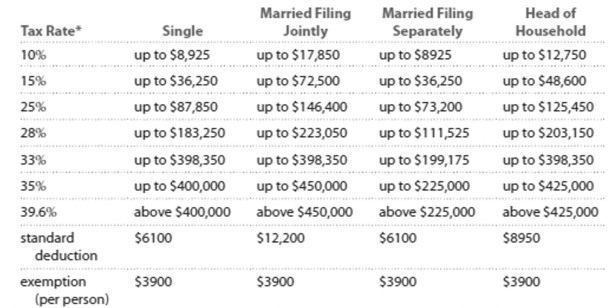Multiple Choice
Solve the problem. Refer to the table if necessary. 2013 Marginal Tax Rates, Standard Deductions, and Exemptlons**
- Each higher marginal rate begins where the prior one leaves off. For example, for a single person, the marginal rate affects income starting at , which is where the rate leaves off, and continuing up to .
" This table ignores the effects of (i) exemption and deduction phase-outs that apply to high-income taxpayers and (ii) the alternative minimum tax (AMT) that affects many middle- and high-income taxpayers.
-You are married filing jointly and have a taxable income of $287,874. You make monthly contributions of $1095 to a tax-deferred savings plan. Calculate the effect on annual take-home pay
Of the tax-deferred contribution.
A) Take-home pay will be $4336 less per year with tax-deferred plan
B) Take-home pay will be $3679 less per year with tax-deferred plan
C) Take-home pay will be $4336 more per year with tax-deferred plan
D) Take-home pay will be $3679 more per year with tax-deferred plan
Correct Answer:

Verified
Correct Answer:
Verified
Q24: Decide whether the statement makes sense. Explain
Q25: Solve the problem.<br>-Calculate the current yield for
Q26: Write the word or phrase that best
Q27: Use the given stock table to answer
Q28: Use the compound interest formula to determine
Q30: You need a loan of $100,000
Q31: Solve the problem. Refer to the table
Q32: Solve the problem. Refer to the
Q33: Solve the equation for the unknown
Q34: Determine whether the spending pattern described is